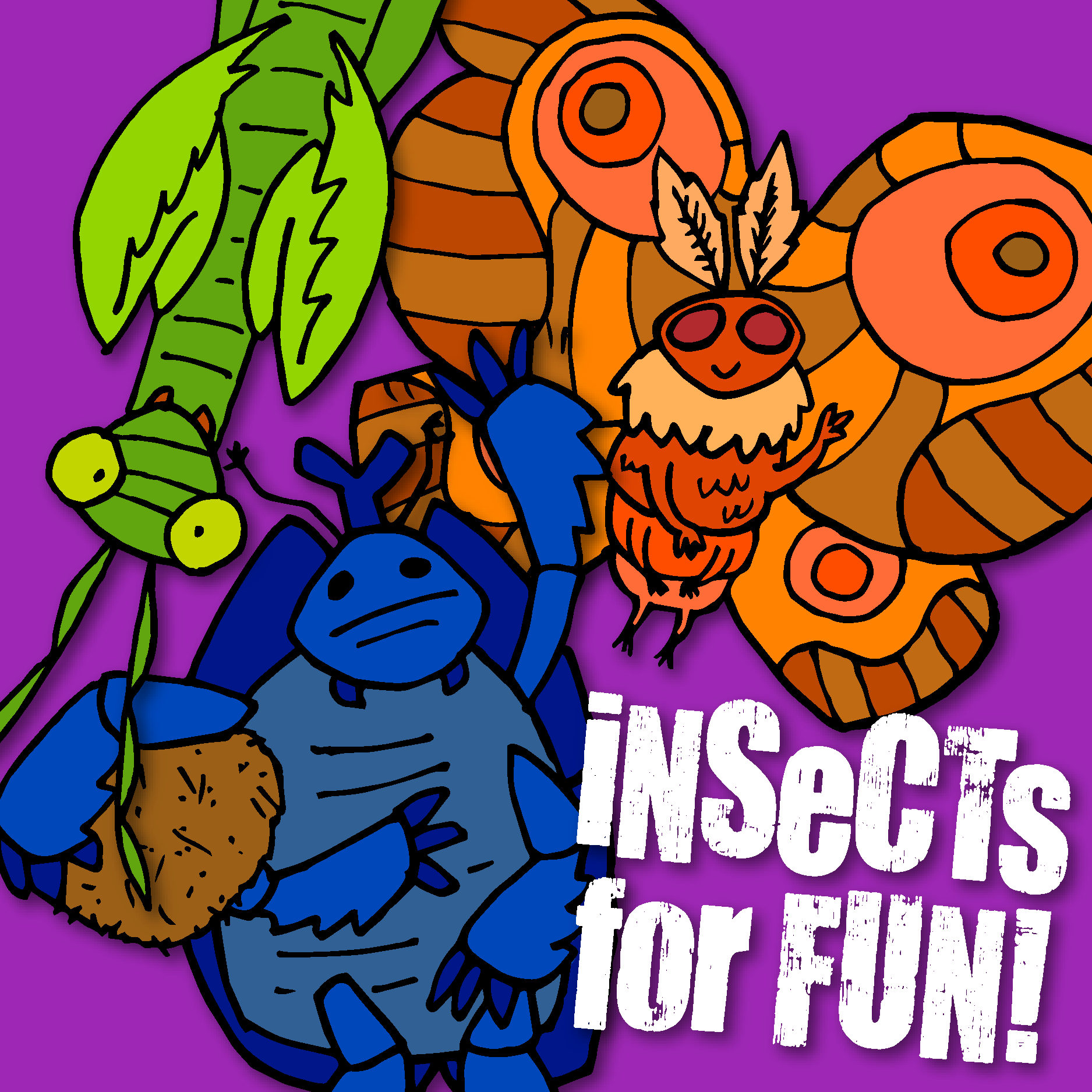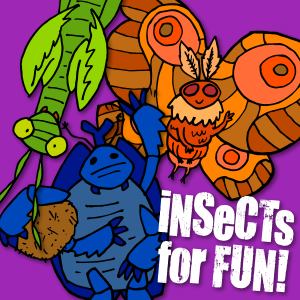Insects for Fun!
An informational podcast covering all things insect and arthropod, hosted by a master in entomology! Join me every Tuesday to learn something new from notable species to broad topics and lore! You can support the show and get extra episodes here: patreon.com/user?u=46499107 Email: Insectsfordummies@gmail.com

Welcome to Insects for Fun!
It doesn't matter if you love or hate insects; this podcast is for everyone! Let's dive into a strange world and uncover crazy facts and mysteries about all things entomology!
Episodes

Tuesday Dec 19, 2023
Tuesday Dec 19, 2023
This week we are talking about the Australian Christmas beetles! What they are, what makes them special, and how their festive looks protect them from heat.
Discord -> https://discord.gg/pDJH3CYcG6
Patreon -> https://www.patreon.com/user?u=46499107
IG: https://www.instagram.com/insects4fun/
FB: https://www.facebook.com/profile.php?id=100085443614825
Email: Insectsfordummies@gmail.com
Music from Lofi Geek

Tuesday Dec 12, 2023
Tuesday Dec 12, 2023
This week we are looking into Bed Bugs, their history, how they become a problem, and what you can do.
Also! The Discord is now officially open :)
Discord -> https://discord.gg/pDJH3CYcG6
Patreon -> https://www.patreon.com/user?u=46499107
IG: https://www.instagram.com/insects4fun/
FB: https://www.facebook.com/profile.php?id=100085443614825
Email: Insectsfordummies@gmail.com
Music from Takada Fu and Toshiki Hayashi

Tuesday Dec 05, 2023
Tuesday Dec 05, 2023
This week we are showcasing large parasitoid wasps that target tarantulas for their young, and why you might not want to bother one.
Patreon -> https://www.patreon.com/user?u=46499107
IG: https://www.instagram.com/insects4fun/
FB: https://www.facebook.com/profile.php?id=100085443614825
Email: Insectsfordummies@gmail.com
Music from Shingo Sekiguchi!

Tuesday Nov 28, 2023
Tuesday Nov 28, 2023
This week we're taking a look at Violin Beetles which are a really unique and underrated insect found exclusively in the tropics of Southeast Asia.
Patreon -> https://www.patreon.com/user?u=46499107
IG: https://www.instagram.com/insects4fun/
FB: https://www.facebook.com/profile.php?id=100085443614825
Email: Insectsfordummies@gmail.com
Music from Shingo Sekiguchi!

Tuesday Nov 21, 2023
Tuesday Nov 21, 2023
This week we look at the origin story of Sea Monkeys along with interesting facts about Brine Shrimp.
Patreon -> https://www.patreon.com/user?u=46499107
IG: https://www.instagram.com/insects4fun/
FB: https://www.facebook.com/profile.php?id=100085443614825
Email: Insectsfordummies@gmail.com
Music from Lofi Girl with featured artists: HM Surf, Purrple Cat, Mell-ø, and Sleepermane

Tuesday Nov 14, 2023
Tuesday Nov 14, 2023
This week we are talking about the invasive and widely spread brown marmorated stink bug; why there are so many of them and why you don't want them around.
Patreon -> https://www.patreon.com/user?u=46499107
IG: https://www.instagram.com/insects4fun/
FB: https://www.facebook.com/profile.php?id=100085443614825
Email: Insectsfordummies@gmail.com
Music from Lofi Girl with featured artists: HM Surf, Purrple Cat, and Blue Wednesday
Transcript:
Welcome to Episode 64 of Insects for fun! The weekly podcast on all things creepy crawly with a focus on insects. Today we’re going to talk about stink bugs because my god there are tons of them right now.
In the fall when weather is starting to cool down a very smelly bug starts to make more and more of an appearance, but today we’re focusing on a specific stink bug called that the Brown marmorated stink bug. This bug is native to China, Japan, and other Asian countries but made its way into the United States in 1998. The state of introduction was Pennsylvania but this smelly bug can now be found throughout many states both east coast and west. Coincidentally it was also introduced into Europe in 1998, but I believe this came after the American introduction. For the European listeners you guys can find these in Germany, Turkey, Switzerland, Italy, Austria and much more recently the United Kingdom (gasp). They’re going to take over the world I’m sure except for Antarctica because well… who can actually stand to tolerate that wasteland. Now where you live might also have native stink bugs, so how can you tell the difference? The brown marmorated is a marbled deep brown in color. This is actually where the term marmorated comes from, and these ones have white bands on their antennae as well as a black and white stripes along the sides of their abdomen.
And yes this is indeed a true bug like all stink bugs and belongs to the family pentatomidae which is in reference to its pentagonal shape. The marmorated stink bug doesn’t only appear in fall though its life cycle begins in spring, but it takes a little while to reach their final form. For example they go through 5 instars or molts and each one takes a week or so to complete. They aren’t anything special to look at either, making them all the more unwanted by most everyone. They’re relatively small too, only reaching about 1.7cm or a little over half an inch, but their smell is incredibly strong, and is often compared with rotting vegetables. I mean if you’ve ever made one angry then I’m sure you know what I’m talking about. But why is it that we only seem to really notice them in the fall if they’re around all summer? These little dudes do not like cold weather, and as a result are actively trying to enter places that can shield them from the cold like your house for example. Or in my case the school that I currently work at because these things are everywhere, and the best part is that my school literally leaves windows open with no screens. They’re straight up asking for stink bugs and then freak out when they enter the school. But this episode isn’t about the dumb things that happen at my school. So now we know these bugs love the indoors when it gets cold, and are really smelly when threatened or scared, but are they bad for us?
Fortunately for you, this stink bug will not bite you, and isn’t harmful to you or your pets! Sure if your dog or cat eats one they might throw up later or get an upset stomach but the bugs are not poisonous or venomous so don’t go rushing them to the vet. Unless something is really wrong, but I haven’t heard of any deathly allergies to stink bugs. I did learn though that people who have an allergy to cockroaches will likely have adverse reactions to the brown marmorated stink bug, and these bugs can release a pheromone to let other stink bugs know they found a good place to hibernate for the winter leading to thousands of stink bugs in your home. One Maryland household had 26,000 individuals which is totally crazy!
On the bright side of things, if they do make their way into your home, garage or shed etc, they aren’t going to cause damage by eating your furniture etc. They won’t even reproduce in your home or eat your food. They really just want to get away from the cold, but of course I don’t blame anyone for not wanting them around. And generally you don’t want these bugs around. In fact New Zealand is actively trying to make sure they don’t enter the island and for good reasons! Jamie I’m counting on you (idk if he still listens to this.. Hope he does!) At any rate these stink bugs are generalists feeding on 100s of plants, and when they feed on plants they cause wilting, bruising, and even less fruit production in hardwood trees. They’ll even feed on the fruits themselves causing lots of losses for farmers! They’re an absolute pain to deal with because a single female can lay up to 500 eggs in batches of 20 to 30 under leaves of host plants. It’s also difficult to find them sometimes, especially on grape farms where they can hide in clusters of grapes. They actually affect the taste of wine too if they get poured into the mix, and this is a result of one of the chemicals they release when stressed called E-2-decenal. This compound is responsible for their stinky smell and is also found in cilantro and most of us know how controversial that plant is.
Something else that was more recently discovered about these annoying little guys is that they leave an invisible footprint on the farms they’re found on. For example researchers at Rutgers University found that traces of brown marmorated stink bugs were in the water that farmers were using to wash their produce. One of the farms they found it in didn’t even have a visible infestation, but on the last day of their surveys a juvenile was discovered in a trap. They were wondering if finding traces of the stink bugs with no visual evidence could be a warning that an infestation is coming.
Now if you’re in an area that has these smelly little monsters around you probably want to know how to get rid of them or prevent them from your home. You might even wanna know regardless to prepare yourself for when they do finally show up, and that part of the show starts now.
Your best line of defense starts before you’ve even seen the enemy. Make sure your living situation doesn’t have cracks or crevices leading to the outside. They’re pretty flexible despite their looks and can fit into slits that are around 4mm in height and holes that are 8mm in diameter, and yes those were statistical findings and we can thank the people at Virginia Tech for figuring those out for us. Also try and keep your outdoor lighting to a minimum if you live in an area with stink bugs. They happen to be attracted to lights at night so you’re basically giving them a welcome home sign. Earlier I said they don’t care about your food, and this is generally the case, but if you leave fruit out in bowls then that might also be attracting them so just keep an eye out for anything suspicious. Also if you’re a household that enjoys using firewood and keeps a stack of it around outside, that could also be a prime location for stink bugs to hide. It’s recommended to keep piles of wood like that at least 20ft away from your house and that’s usually a good idea regardless because as we learned in the carpenter bee episode those make good little hotels for bees too.
I’ve got a really weird one now for you. Fragrant Dryer sheets. Apparently stink bugs are not a fan of these so if you wipe down your windows and door screens etc with dryer sheets you can repel up to 80% of unwanted stink bugs. (That’s pretty neat!)
But some of you might be saying “But I already have them in my home! What do I do now?”
I’m going to share some tips and trips but first a disclaimer. I’m not a professional in pest management. If you have a lot of stink bugs or ANYTHING in your home do yourself a favor and get a professional in there. If you don’t have a serious problem and just want tips to help keep your space free of them then these tips are for you.
Flick them into plastic bottles to contain their stench and pheromones
Don’t squash them or use hard pesticides in your home, you’ll likely make the problem worse.
Okay this one is pretty good, get yourself a shot vac and fill the canister with soapy water. Then just go ham and suck all the stink bugs up. It’s not recommended you use a regular vacuum because the smell is incredibly pungent and can stain the lining of a regular vacuum.
We’ve talked a lot about what these stink bugs eat and how we can get rid of them but are there any animals that willingly eat these? The answer is yes! The majority of these are other arthropods though like spiders, and predatory insects, and the life stage at which these are most consumed would be eggs. Katydids, Crickets, Slugs, Ladybugs, even other stink bugs will all happily feed on marmorated stink bug eggs, but there is one predatory that takes the cake by far, and that would be the samurai wasp Trissolcus japonicus which is native to Japan. This parasitoid wasp is responsible for over 50% of egg mortality in an egg mass, and they also prioritize the brown marmorated stink bug over other bugs. The funny part is it wasn’t introduced purposefully into the states but managed to get here anyway and now people in the U.S. are like dang, can we buy these in bulk? (I’ll take 20! Spongebob quote) It’s also now found in Europe and Chile, and it seems to follow the marmorated stink bugs wherever they go. The best part is that they even overwinter which means that they can survive colder climates! As for purchasing these, they are not widely available like other parasitoids but maybe someday they will be.
That wraps up today’s episode! As always if you enjoy the show please rate it and review if you can as that is the number 1 way to grow our community other than word of mouth. If you want more content or just wat to support the show you can find it at Patreon.com/Insects for Fun
If you have a listener request you can send it to Insectsfordummies@gmail.com and of course be sure to check out the instagram and or fb page for photos and possibly videos. I made a Tiktok account for this which has close to 900 followers now so I’ll probably add videos on IG reels or something as well. There is also the YT channel!
Anyway Thanks for listening and you’ll hear from me again next week.

Tuesday Nov 07, 2023
Tuesday Nov 07, 2023
This week we are literally diving into the topic of crustaceans and how they're related to insects, but that's not all. Let's also take a closer look at lobsters and learn some interesting history.
Patreon -> https://www.patreon.com/user?u=46499107
IG: https://www.instagram.com/insects4fun/
FB: https://www.facebook.com/profile.php?id=100085443614825
Email: Insectsfordummies@gmail.com
Music from Lofi Girl with featured artists: HM Surf, and Purrple Cat
Transcript:
Welcome to episode 63 of Insects for fun! Only today we’re not talking about insects exclusively. This is a bridge episode which is going to link us into all further episodes relating to crustaceans because there’s a lot and I don’t want to have to keep explaining their relationship every time. SO! Here we go (underwater bubbles)
Remember that episode I did talking about how not all insects are bugs but all bugs are insects? Well here’s a new one for ya. All insects are actually crustaceans, but not all crustaceans aren’t insects (HUH) and no, spiders, scorpions, millipedes, centipedes, and horseshoe crabs are not crustaceans which means that yes, lobsters, shrimp and crabs are more closely related to insects than arachnids, and those other creepy crawly arthropods. Let’s go back in time to where it all began which would be the Cambrian period. At this time the earth did have land masses but Pangea was not a thing, and these land masses were very very bare. Almost all life was still in the ocean and it was here that Crustaceans first came into existence.
So what do Crustaceans and Insects have in common then? Well, for starters they both rely on an exoskeleton made of chitin, and they both start out as an egg and go through a series of molts to reach their adult stage. They also both have compound eyes and antennae! Yeah that’s right, even crabs have antennae, and crazier still is that crustaceans actually have two pairs of antennae unlike insects which only have one. But the similarities go deeper than this, and by that I’m referring to their insides. Both of them share the same proteins for transporting oxygen, and they’re circulatory systems are also controlled by the same peptides. I think it’s safe to say that yes. Insects are indeed crustaceans, and when we eat shrimp, crab and lobster, we’re basically just eating big ocean bugs.
But are Lobsters really just roaches of the sea? How did that myth even start in the first place? Believe it or not there was a time when Lobsters were actually referred to as the poor man’s chicken or even cockroaches of the sea in the United States. Back in the 1600 and 1700s the full potential of a lobster's taste had yet to be unlocked and people really didn’t know how delicious they could be. As a result piles and piles of lobsters would wash up on the shores and people didn’t know what to do with them because they certainly weren’t going to eat them. But the reason lobsters began to really pique people’s interest started with the transportation system. As more and more railroads were being built, and more and more passengers were riding trains for longer periods of time; food had to be made available and what better than to offer cheap and common Lobster! More and more people began eating lobster and became curious about the methods one could cook it, and now here we are. Lobster is considered a delicacy and fetches a high price.
So now that we have the knowledge of what a crustacean is, and the history of lobsters in the states. Let’s look at what exactly a Lobster is, and come to a conclusion as to whether they’re indeed overpriced cockroaches or not.
Not all lobsters are the same, and many crustaceans which have lobster in the name are not true lobsters. Today we are looking specifically at clawed lobsters in the family Nephropidae of which there are around 54! Not too many which is kind of surprising, and I think there must be more as well considering they all say we know more about our solar system than we do about the oceans on earth. These clawed lobsters have 10 legs but only 8 are used for walking. The front three pairs all have claws, so yeah the big claws we crack open and eat are just one pair of 3 legs!
Now here’s where it starts to get quite familiar… the body of a lobster contains three segments. The head, thorax, and abdomen, but with most crustaceans, the head and thorax are fused into something called a cephalothorax! Lobsters also contain large compound eyes, and get this, three pairs of antennae… yeah! The two really long ones we see are used for feeling the ground and the others are for picking up chemicals scents in the water. Some of you might be wondering what the smaller leg things are under the tail of a lobster, and those are called pleopods or swimmerets and they help with swimming!
In general clawed lobsters are on the larger side between 25 - 50cm or 10 and 20inches, I mean I’m sure many of us have seen one form of them before, but it does vary depending on where the species lives. For example deep sea lobsters will naturally be smaller in comparison to a big ol red maine lobster for example. The lobster in Japan are also on the smaller side, but I find that most things other than insects tend to be smaller over here.
And speaking of where they live… these lobsters can be found in all the oceans on sandy floors, rocky bottoms, muddy floors, as close as the shoreline to out past the continental shelf into the deep with larger lobsters being further out. Lobsters usually get around by walking along the floor but they can be pretty speedy when they need to! A lobster's escape involves flicking the tail and pushing itself backwards with a max speed recorded at 11mph. They don’t just use their legs for walking though. They actually taste with the front walking legs. They also chew with their stomach, not their mouth. They’ve got something called a gastric mill which is basically a food compactor in their stomach that grinds down everything. Now of course a lobster can’t just swallow things whole the way birds often do, and that’s where the large claws come in. These guys usually break open and rip apart their meal to get it into smaller bite size chunks before getting further crushed in the stomach. The claws can use up to 100 pounds of pressure and are the go to cracking open and eating crabs, clams, mussels and sometimes… even other lobsters.
Now let’s take a look at the longevity of a lobster because rumors are that these creatures are insanely resilient, just like a roach, and it is also rumored that lobsters are biologically immortal! Let’s take a look at the facts. Humans and other animals are designed to degrade because as our cells divide and continue to be born again, a small piece of them doesn’t come back until eventually the cells just simply stop dividing. This small tip at the end of our cell's coding is called a telomere. If we’re to think of this in fishing terms it would be like never being able to replace the line on your rod, and you don’t have a swivel, so you need to cut your line a tiny bit every time you change lures and that line is only getting shorter until you simply can’t fish anymore. Now lobsters on the other hand do have a swivel which means they can keep swapping out lures without having to take any line away and this swivel is an enzyme called telemorase. So yeah. Lobsters are in fact biologically immortal. They actually get more fertile with age, so then why do lobsters die? Unfortunately Lobsters have to keep shedding their skin as they age and grow, and to do this they require more energy and calories, so instead of dying from old age, lobsters actually die from exhaustion. At a certain point they simply cannot get enough calories to replace their shells and that’s the end of it. So in our earlier example the fishing rod of a lobster gets more and more thick until eventually you can’t even lift it anymore to go fishing. They can also regenerate limbs, but it’s going to take some time. For example a one pound lobster will need about 5 years to regrow one of its larger claws. And yes lobsters feel pain! I don’t care what chefs say or anyone in the food industry. They have sensitive hairs all over their body and an incredibly complex nervous system. There is so much misleading information made publicly available by people who really don’t have a clue. For example I read on a Maine Lobster Company website that insects and lobsters don’t have brains so they don’t feel pain. (dumb dumb dumb dumb)
Earlier we got into the history of lobsters as a food source, but did you know that lobsters actually get grades? There are three grades given to a lobster upon its catch and those are either new shell, hard shell or old shell and the price for each one increases with hardness. The reason is that harder lobsters can be shipped further away, but the meat is coarser. New shell lobsters are incredibly fragile and cannot be transported far. The meat is tender and more sweet when compared with harder shelled lobsters. Here’s a fun fact, lobster shells can be used to make golf balls! They look the same, but only have 70% of the power.
Okay it’s time for conclusions on whether lobsters are actually roaches of the sea (drum roll) It’s a no! They share similarities for sure, but they are not close enough on the family tree or even through appearance to be considered. There are definitely sea roaches though but that’s for another episode…
That wraps up today’s topic! If you enjoyed the episode or enjoy the podcast make sure to give a rating and review if you can so more people can find the show! If you want bonus episodes on topics relating to insect news and other noteworthy discoveries you can find those along with vlogs at Patreon.com/insects for fun. If you have a listener submission you can send to me via IG at insect(number 4)fun or through a fb message OR send me an email at insectsfordummies@gmail.com.
Thanks again for listening and you’ll hear from me next week.

Friday Nov 03, 2023
Friday Nov 03, 2023
This is another bonus episode covering spooky tales from people on the internet as well as the news!
Patreon -> https://www.patreon.com/user?u=46499107
IG: https://www.instagram.com/insects4fun/
FB: https://www.facebook.com/profile.php?id=100085443614825
Email: Insectsfordummies@gmail.com

Tuesday Oct 31, 2023
Tuesday Oct 31, 2023
This week we are looking into one of the most feared centipedes and it is purely based on its looks! Another reason why we can't judge a book by its cover.. The house centipede is an amazing hunter of all things we really don't want in our homes.
Patreon -> https://www.patreon.com/user?u=46499107
IG: https://www.instagram.com/insects4fun/
FB: https://www.facebook.com/profile.php?id=100085443614825
Email: Insectsfordummies@gmail.com
Music from Lofi Girl featuring: Sebastian Kamae, Sleepermqne, and HM Surf
Transcript:
Welcome to episode 62 of insects for fun! The weekly entomology podcast covering all things insect and arthropod! Oo that’s new… yup I have now opened the floodgates for all arthropods, and today we will be looking at just one of many oddballs commonly called a house centipede.
House centipedes are a group of arthropods in the order scutigeromorpha which happens to be one of many centipedes, but these ones don’t resemble a centipede at all, and they actually look and share more similarities with insects such as full compound eyes, and long jointed legs. Compound eyes means that they can detect movement at incredible speeds, but their vision is actually super blurry. Imagine looking at a wall of monitors and each monitor is showing the same image. It’s super easy to notice when something is moving but you can forget about having a nice big clean image. And speaking of clean images.. the house centipede is definitely not a sight for the faint of heart, especially for those who are scared of creepy crawlies. Their bodies are only between 1 and 1.5 inches in length and slender, but they have 15 pairs of legs which are long and surround the entire body making them appear much larger. The hind legs are actually longer than the forelegs so they can overlap while running without getting tangled and females have two extremely long legs at the very back of their bodies which act as secondary antennae. Honestly if you’ve seen one before you’ll never forget how it looks because they’re really wild. They also happen to be incredibly fast, reaching speeds of 0.4 meters per second or 1.3 feet which is pretty good, and they can traverse almost any surface. There are 25 genera which means there are at least 25 species, but I honestly can’t say how many there are. The most well known species is Scutigera coleoptrata with Scutigera in reference to bear a shield and the Coleoptrata part is like coleoptera which is the order for Beetles because these centipedes have a thorax that’s kind of similar.
But where did these things even come from? And where can you find them now? Well, house centipedes actually originated in the mediterranean, but are now commonly found throughout the world, and because they live in homes and close to humans it’s pretty easy for them to travel. That being said house centipedes didn’t just randomly appear in our homes.They started out in the wild like the roaches from last episode, and these guys prefer to live in damp, cool, and dark places like under logs, tree bark, rocks etc. They’re a nocturnal group and are rarely seen in daylight. I personally almost never see them in the wild, but I have encountered them in buildings. Actually the first time I saw one was in 4th grade at school. I had no idea what it was but it was so crazy looking to me that I really wanted a closer look. These things are incredibly fast though as I mentioned, and I had no such luck.
Another feature to house centipedes which adds to their swiftness would be tracheal lungs. With these the centipede can breathe while it’s on the run!
Okay so now we know where they started and where they dwell in nature, but why our homes? Well! You’ll be happy to know that these critters don’t care about your food, books, or furniture etc. The house centipede is a predator and prefers live food, which it has no problem catching by the way, and because of this you usually only encounter them in your home if you’ve got another problem… like roaches, bed bugs, silverfish etc. Having these guys around in your home is actually quite helpful and they can’t hurt us at all. Think of them as a creepy roomba for arthropod pests, but with a Turbo mod. Some people fear that the creatures can bite you and are venomous to us. But have no fear! They can’t do damage to us, and honestly they don’t want to either. House centipedes are shy, and even when handled won’t be aggressive towards you. That being said they do actually contain venom which is only potent enough for small arthropods like roaches. They can’t really bite either… These centipedes have two modified forelegs called forcipules, and they’re used to slow down prey that has been captured by their other legs. One article I read states that the centipedes wrangle their prey like cowboys using their legs as lassos to corral and catch their victims. She also mentioned that she handles them all the time for her research and has never once been attacked. You know actually something funny I’ve noticed is that the majority of my listeners are women! Are you surprised? I really do think men are more afraid to be honest, and a study done in 2019 found that out of 2,000 Americans surveyed a larger percentage of men claimed to be very afraid of insects. I'm pretty sure I haven’t said that before on the show but if I did, sorry. It’s actually hard to keep track of all the small pieces of information I’ve written and said when it’s just me doing this!
Anyway, house centipedes move around the world by hiding in furniture like rugs or even couches? But please don’t go tearing into your couch looking for something because there is a very good chance you don’t even have them in your home to begin with. Now speaking of beginnings, house centipedes start their life as an egg, and go through a series of molts just like insects! They have 10 molts to be exact, and for the first 5 they grow new legs! The first instar of a house centipede only has 4 and the next molt has 6 with the other 4 molts adding two new ones each time and here’s the crazy part. They can live up to 7 years! Yeah, that’s extremely long for something that is so similar to an insect, and it takes them 3 years to reach sexual maturity. Now I saw something online stating that they prefer winter outdoors but I feel like whoever wrote that probably lived in a tropical climate where summers are unbearable. I mean even Florida to me in the summer is pretty unbearable and I’d much rather be indoors with air conditioning. If you live in a colder climate like New England then you can be sure they’re spending those winters indoors. Especially because they can’t tolerate colder temperatures. It’s a surprise at all that they made it up past Mexico, but I guess being fast and nocturnal has allowed them to stay out of harm's way in close quarters to people. Which brings me to my final point. If you do indeed have this in your home, and you see them quite frequently that means you have a much bigger problem. To remove house centipedes you need to first remove their food, and like I said if they’re around that means you have enough of an actual pest problem which lured them there, and that’s not an easy task. As always regardless of the pest insect, if it’s a lot then you’re better off getting a professional as opposed to turning your home into a home alone film against insects.

Friday Oct 27, 2023
Friday Oct 27, 2023
This is a special episode to celebrate Halloween! Within the episode is a collection of scary and creepy tales written by the users who experienced them and narrated by me. Hope you guys enjoy it!
Patreon -> https://www.patreon.com/user?u=46499107
IG: https://www.instagram.com/insects4fun/
FB: https://www.facebook.com/profile.php?id=100085443614825
Email: Insectsfordummies@gmail.com










